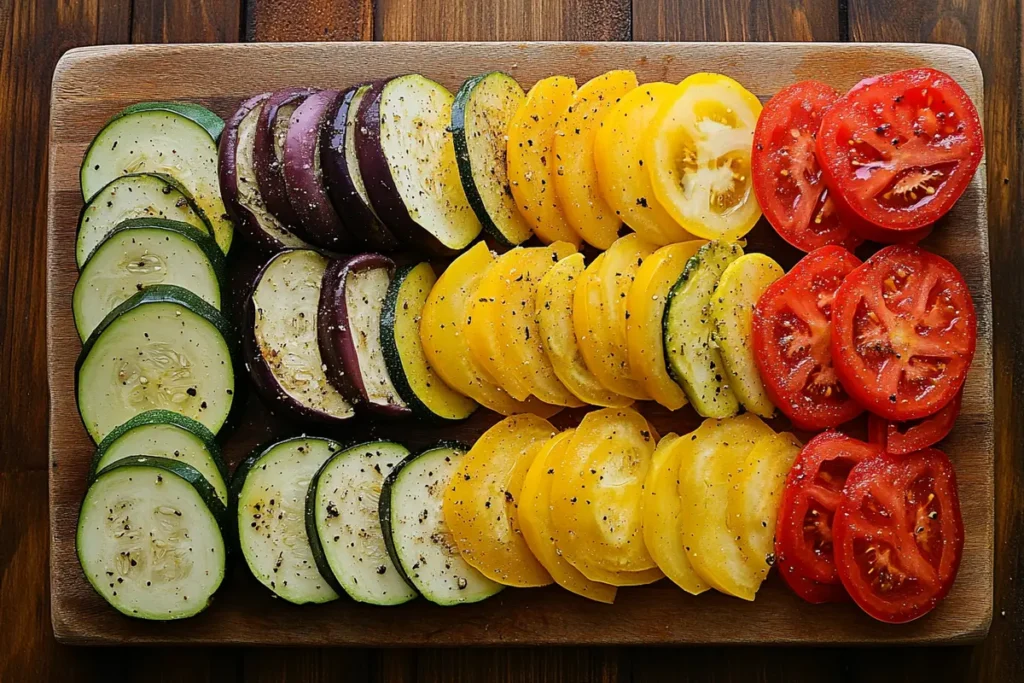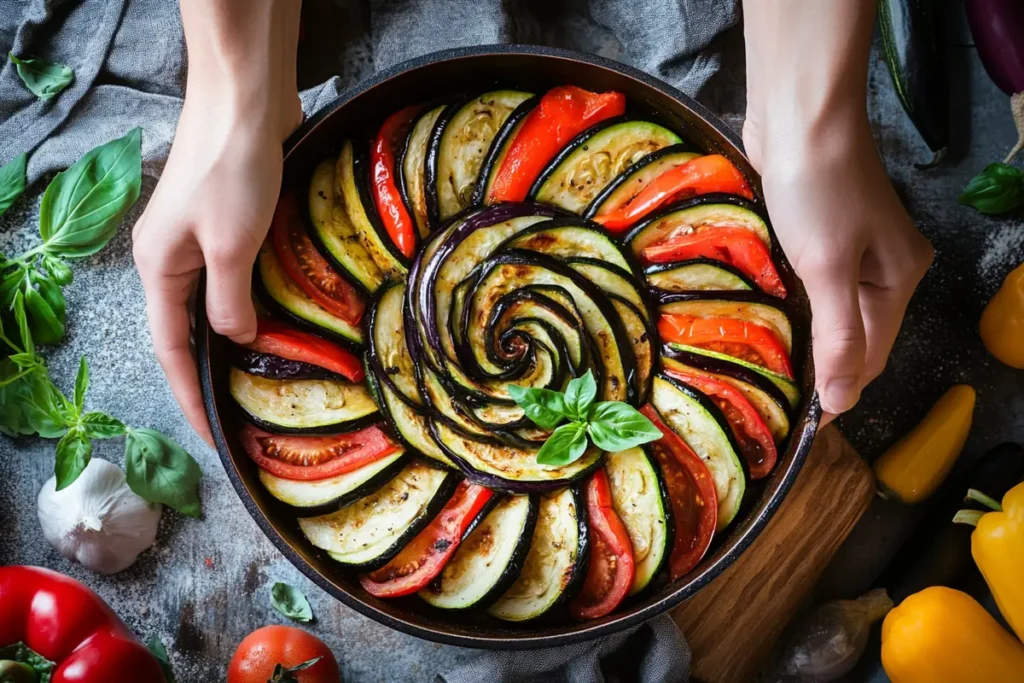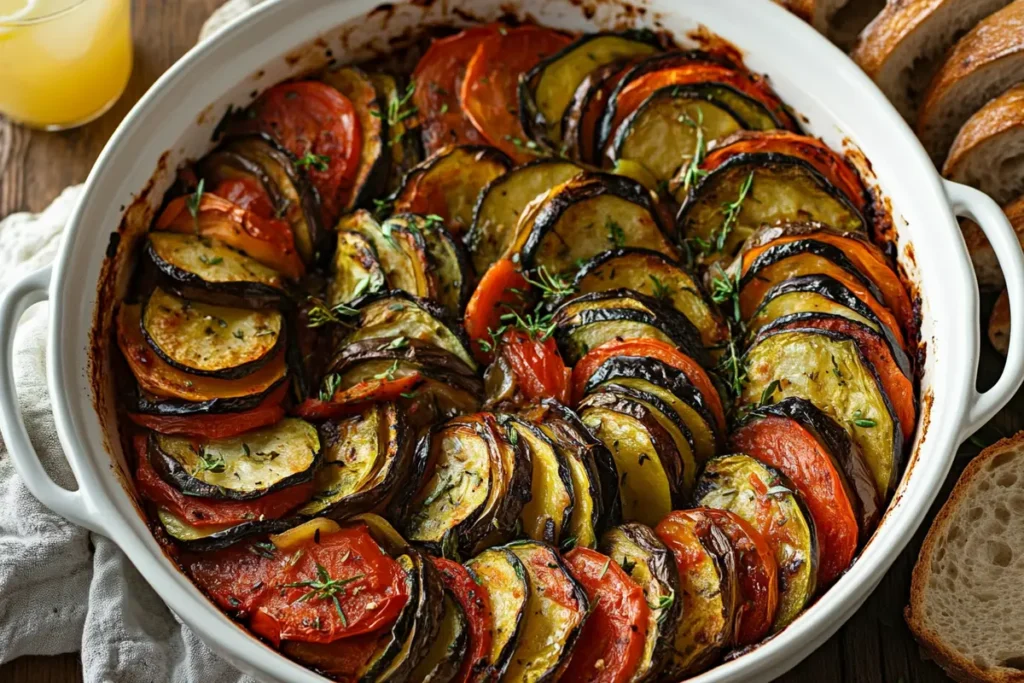You know, I still remember the first time I made baked ratatouille in my tiny Roman kitchen. It was late summer, and the market was bursting with fresh zucchini, eggplants, and vine-ripened tomatoes. My nonna used to make ratatouille the traditional way—on the stovetop—but I decided to try something different. I layered the vegetables in a spiral, drizzled them with olive oil and herbs, and let them bake slowly. The aroma filled my flat and caught the attention of my neighbor, who knocked just to ask what was cooking. That moment made me fall in love with this dish—not just for the taste, but for the joy it brings when shared.
Whether you’re a seasoned home cook or a kitchen newbie, this guide will walk you through everything you need to know about making baked ratatouille—from its roots and ingredients to preparation, baking, and even serving ideas. Let’s dive into the heart of this French vegetable classic.
Understanding Ratatouille
What Is Baked Ratatouille?
At its core, ratatouille is a traditional French dish hailing from the sun-drenched region of Provence. It’s a humble, rustic medley of vegetables—think eggplant, zucchini, bell peppers, onions, and tomatoes—slow-cooked with Mediterranean herbs like thyme and basil. While the original version is stewed, the baked ratatouille variation takes a modern, artistic twist, layering thinly sliced veggies in a beautiful spiral and roasting them to perfection. The result? A dish that’s as visually stunning as it is delicious.
This oven-baked ratatouille recipe not only preserves the vibrant flavors of summer produce but also intensifies them through roasting. The edges of the vegetables caramelize slightly, and the juices meld into a rich, herby base. No wonder it’s become a favorite among fans of healthy vegetarian dishes and Mediterranean flavors.
Traditional vs. Baked Ratatouille
Now, let’s break it down. The traditional ratatouille is more of a stovetop stew, often involving sautéing vegetables separately before simmering them together. It’s hearty and flavorful but not the prettiest on a plate.
Enter baked ratatouille: a visually appealing evolution that maintains all the Provencal cuisine charm with a touch of elegance. Here, vegetables are carefully arranged—usually in a circular or fan-like pattern—then baked slowly over a tomato-based sauce or herbed oil. It’s the kind of dish that earns oohs and ahhs at the dinner table, yet it’s surprisingly easy to prepare.
Ingredients for Baked Ratatouille
Essential Vegetables

To craft an authentic baked ratatouille, you’ll need a vibrant selection of fresh vegetables. The stars of this French vegetable casserole include:
- Eggplant: Choose firm, glossy-skinned eggplants without blemishes.
- Zucchini: Opt for small to medium-sized zucchinis that are tender.
- Bell Peppers: Use a mix of red, yellow, and green peppers for a colorful presentation.
- Tomatoes: Select ripe, firm tomatoes like Roma or plum varieties.
- Onions: Yellow onions add a subtle sweetness to the dish.
Herbs and Seasonings
The Mediterranean flavors of baked ratatouille are elevated by aromatic herbs and seasonings:
- Fresh Basil: Adds a sweet, peppery note.
- Thyme: Provides earthy undertones.
- Garlic: Enhances depth and richness.
- Olive Oil: Use extra-virgin for its fruity flavor.
- Salt and Pepper: To season and balance the flavors.
Choosing Quality Produce
For the best-tasting oven-baked ratatouille recipe, prioritize fresh, organic produce. Visit local farmers’ markets to find seasonal vegetables at their peak. Freshness ensures vibrant flavors and a delightful texture in your healthy vegetarian dish.
Preparing the Vegetables
Washing and Cutting Techniques
Proper preparation is key to a successful roasted vegetable medley:
- Washing: Rinse all vegetables under cold running water to remove dirt and residues.
- Slicing: Cut the eggplant, zucchini, bell peppers, and tomatoes into uniform, thin slices—about 1/8 inch thick. Consistent slicing ensures even cooking and a pleasing presentation.
Salting Eggplant: Necessary or Not?
Salting eggplant can help draw out bitterness and excess moisture. To do this, sprinkle salt over the slices and let them sit for about 20 minutes. Afterward, rinse and pat them dry with a paper towel. While modern eggplant varieties are less bitter, this step can enhance the texture of your oven-baked ratatouille recipe by preventing sogginess.
By carefully selecting and preparing your ingredients, you’re well on your way to creating a delectable baked ratatouille that showcases the best of Provencal cuisine. Stay tuned for the next steps in assembling and baking this traditional French dish.
Layering and Assembling Baked Ratatouille
Choosing the Right Baking Dish
Selecting an appropriate baking dish is crucial for your baked ratatouille. A shallow, round or oval dish, approximately 10 to 12 inches in diameter, works best. Materials like ceramic or glass ensure even heat distribution, promoting uniform cooking. Additionally, these materials retain heat well, keeping your dish warm when served.
Artistic Arrangement Techniques

The visual appeal of baked ratatouille lies in its meticulous arrangement. Begin by spreading a thin layer of tomato sauce or a drizzle of olive oil mixed with minced garlic and herbs at the bottom of your baking dish. Then, alternate slices of eggplant, zucchini, bell pepper, and tomato, slightly overlapping each piece, creating a colorful spiral or concentric pattern. This not only enhances the dish’s aesthetic but also ensures even cooking and flavor infusion.
Incorporating Sauces and Cheeses
To elevate the flavors of your baked ratatouille, consider adding sauces and cheeses. A light drizzle of olive oil infused with herbs can enhance the vegetables’ natural taste. For a richer profile, sprinkle crumbled goat cheese or shredded mozzarella between the vegetable layers. These additions introduce a creamy texture and a delightful depth of flavor, complementing the roasted vegetables beautifully.
Baking Process and Tips
Optimal Oven Temperature and Timing
Achieving the perfect baked ratatouille requires precise oven settings. Preheat your oven to 375°F (190°C). Once assembled, cover the dish with aluminum foil and bake for 40 minutes. After this initial period, remove the foil and continue baking for an additional 20 minutes. This method allows the vegetables to become tender while developing a slight caramelization on the edges, enhancing the dish’s overall flavor.
Covering vs. Uncovering During Baking
The decision to cover or uncover your baked ratatouille during baking impacts its texture and moisture content. Covering the dish with foil during the first phase traps steam, ensuring the vegetables cook evenly and retain their natural juices. Uncovering it later allows excess moisture to evaporate, promoting a desirable caramelization and preventing the dish from becoming too watery.
Checking for Doneness
To determine if your baked ratatouille is ready, insert a fork or knife into the center of the dish. The vegetables should be tender and offer little resistance. Additionally, the edges should exhibit a slight golden-brown hue, indicating caramelization. If the vegetables are still firm, extend the baking time by 5-10 minutes, checking periodically to avoid overcooking.
Serving Suggestions and Pairings

Ideal Side Dishes for Baked Ratatouille
So, you’ve pulled a steaming dish of baked ratatouille out of the oven—what next? Well, this vibrant dish shines on its own, but it pairs beautifully with several sides. Crusty French bread or warm, toasted baguettes are ideal for mopping up the herby juices, cottage cheese flatbread. For a more filling meal, serve it with a side of rice, quinoa, or even creamy mashed potatoes.
If you’re going low-carb, try pairing it with cauliflower rice or a light salad with lemon vinaigrette. Each bite complements the Mediterranean flavors and makes your baked ratatouille the star of the plate.
Wine Pairings to Elevate the Experience
Want to take dinner up a notch? Pair your baked ratatouille with wine. A light, crisp white wine like Sauvignon Blanc adds brightness, while a medium-bodied red such as Pinot Noir enhances the roasted, herby notes.
Prefer something non-alcoholic? Go for sparkling water with a twist of lemon or a cool glass of iced herbal tea. These drinks refresh the palate and let the vegetables’ natural sweetness shine through.
Presentation Tips to Impress
Don’t forget—presentation matters! Serve your oven-baked ratatouille recipe in the same dish you baked it in, letting the spiral of colors do the talking.Top it with a fresh basil sprig or a sprinkle of grated Parmesan for that final flourish.Your guests will be hooked before the first bite.
Variations and Dietary Adaptations
Vegan and Gluten-Free Options for Baked Ratatouille
One of the best things about baked ratatouille? It’s naturally vegan and gluten-free! That means it’s perfect for a wide variety of diets without needing much tweaking. However, if you’re adding cheese, make sure to use a plant-based option to keep it vegan-friendly.
For gluten-free folks, just avoid any bread pairings with gluten—or swap in gluten-free bread or grains. You’ll still enjoy the same comforting, nutritious flavor of this healthy vegetarian dish.
Protein Additions to Bulk It Up
If you’re craving a heartier meal, baked ratatouille makes a great base for proteins. Add grilled chicken breast, roasted chickpeas, or seared tofu slices on top for extra substance. These options blend seamlessly with the herb-infused vegetable casserole without overpowering the dish.
Spice and Flavor Twists
Feeling adventurous? Add your own twist with bold spices or new herbs. Try cumin for a smoky depth or chili flakes for heat. You can also stir in sun-dried tomatoes or olives for a Mediterranean upgrade.
Want to lean more Eastern European? Toss in a pinch of paprika or caraway seeds for a completely different but delightful spin on your baked ratatouille.
Common Mistakes to Avoid
Overcooking Vegetables
One of the easiest ways to mess up baked ratatouille is by overcooking the veggies. When vegetables are baked too long, they lose their texture and turn mushy. To avoid this, always slice them evenly and keep an eye on your oven during the final 10 minutes.
Remember, you want tender—not soggy—vegetables that still hold their shape. The beauty of this roasted vegetable medley lies in its slight bite and vibrant layers.
Underseasoning
Even with the freshest produce, baked ratatouille can fall flat without proper seasoning. Don’t just rely on salt and pepper. Make sure to layer in herbs like thyme, basil, and oregano for a rich, aromatic profile.
Also, don’t be shy with garlic or a splash of good olive oil. They bring out the natural sweetness of the veggies and tie everything together beautifully.
Skipping Resting Time
Once out of the oven, resist the urge to serve immediately. Let your baked ratatouille sit for at least 10–15 minutes. Why? Because this resting period allows the flavors to blend and the juices to settle. It’s a small step that makes a big difference.
Frequently Asked Questions About Baked Ratatouille
Can I Make Baked Ratatouille Ahead of Time?
Yes, absolutely! Baked ratatouille actually gets better with time. You can make it a day ahead, let it cool, and store it in the fridge. When reheated gently, the flavors deepen, and the texture stays lovely.
How Do I Prevent My Ratatouille from Being Watery?
Great question! To avoid a watery dish, make sure to slice vegetables thinly and evenly. Also, don’t skip the step of salting the eggplant—it really helps. Finally, uncovering the dish during the last 20 minutes of baking allows excess moisture to evaporate, giving you that perfect consistency.
Is It Necessary to Peel the Vegetables?
Nope, not at all. For baked ratatouille, the skin adds texture and helps the slices hold their shape. Unless you have a personal preference or dietary need, there’s no reason to peel the veggies. Besides, leaving the skin on keeps the prep simple and the dish colorful.
Can I Freeze Baked Ratatouille?
Yes, you can. Let the dish cool completely before storing it in an airtight container. It will keep in the freezer for up to two months. To serve, thaw overnight in the fridge and reheat gently in the oven.
Just note that the texture may soften slightly after freezing, but the flavor will still be spot on.
Conclusion
There’s something magical about pulling a bubbling dish of baked ratatouille from the oven—the colorful layers, the herby aroma, and that first warm, savory bite. Whether you’re hosting a summer dinner or craving something wholesome on a chilly evening, this traditional French dish delivers both beauty and flavor.
From carefully sliced vegetables to bold herbs and creative twists, you now have everything you need to master the art of this healthy vegetarian dish. Remember, the best dishes aren’t just about technique—they’re about heart, stories, and sharing.
So go ahead, make it your own. Try different herbs, experiment with sauces, or toss in a protein. Just don’t forget to serve it with love.

